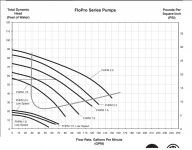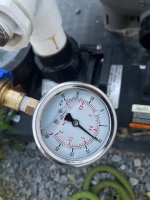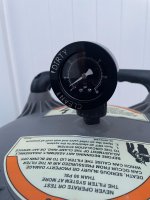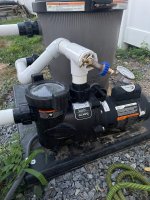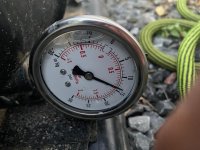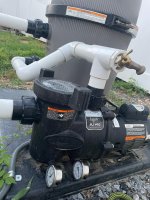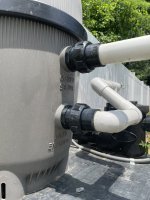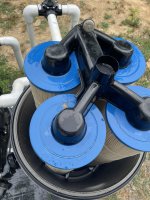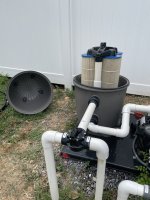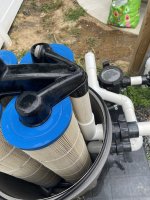The pipes are connected correctly to the filter tank. As shown in the pic, the pump discharge is connected to the lower part of the tank. The pipe connected to the upper part of the tank goes to the return lines to the pool.
Pressure gauge indicates zero during normal operation???
- Thread starter KCD
- Start date
You are using an out of date browser. It may not display this or other websites correctly.
You should upgrade or use an alternative browser.
You should upgrade or use an alternative browser.
Can you recommend a decent vacuum gauge for this pump? I need to determine the flow rate and a delta p across the pump will allow me to do this.
I measured the delta p across the pump using vacuum/pressure gauge. It’s approximately 24 psi, which corresponds to a fIow rate of 40 gpm. This would take 8 hrs to recirculate the pool.
What was the suction pressure?I measured the delta p across the pump using vacuum/pressure gauge. It’s approximately 24 psi, which corresponds to a fIow rate of 40 gpm.
Seems like you have a serious suction blockage.
Are you sure that you are reading the vacuum pressure correctly?
What units is the gauge in?
Last edited:
Update: recalculation shows 42.5 feet TDH, which corresponds to 90 gpm on the pump curve. An increase in 10 psi due to dirty filter would correspond to 40 gpm on the pump curve. So, as the filter gets dirtier, the flow decreases from 90 to 40 gpm at 10 psi increase in the pump discharge pressure. I would run the pump 4 hrs per day to recirculate the pool volume of 20,000 gallons when the filter is clean to 8 hrs per day when the filter gets dirtier to the point where there is a 10 psi increase in the pressure. Vacuum: 9 Hg at pump inlet. Pressure 14 psi at pump outlet. See pics.
The pressure is 14 psi at the pump but drops to 11 psi at the hose connection and to 4 psi at the top of the filtration tank.
Attachments
Last edited:
That's a really big difference.The pressure is 14 psi at the pump but drops to 11 psi at the hose connection and to 4 psi at the top of the filtration tank.
Can you show the cartridges?
Can you show the writing on the filter where it says inlet and outlet?
You're over worried about "Turnover".I would run the pump 4 hrs per day to recirculate the pool volume of 20,000 gallons when the filter is clean to 8 hrs per day when the filter gets dirtier to the point where there is a 10 psi increase in the pressure.
Turnover really does not matter for a residential pool.
I would insist on a variable speed pump and run it at about 20 to 25 GPM.
Your pump is a huge waste of money and that is why they are now illegal to make.
That's a really big difference.
Can you show the cartridges?
Can you show the writing on the filter where it says inlet and outlet
Attachments
Ok, the pressure should be about the same.
Maybe a bad pressure gauge.
Can you show the cartridges?
Maybe a bad pressure gauge.
Can you show the cartridges?
You're over worried about "Turnover".
I mentioned the pump issue with the PB but he does not want to replace it. I don’t think it’s illegal for him to not replace it, even though the pool has yet to pass final inspection and is still under construction. What else can I do?Your pump is a huge waste of money and that is why they are now illegal to make.
Why is it that turnover is not important in residential pools? I was under the impression that the pump should be run long enough to filter the entire pool volume once per day.
The pump needs to run for a reason.Why is it that turnover is not important in residential pools?
The reasons can be for making chlorine from a SWG or a tab feeder, or skimming, filtration or heating.
Filtration depends on what gets in the water.
So, an arbitrary “Turnover” time is really not relevant.
The most efficient operating model for a residential pool is to run at about 20 to 25 GPM 24/7.
20 to 25 GPM should give good skimming action and provide enough flow to activate a SWG.
Heaters need about 10 GPM per 100,000 btu/hr, so you would want a pump that could run at 20 to 25 GPM until there was a call for heat and then you want the pump to ramp up to heating speed until the call for heat is over.
Cartridges are the same as the ones shown in response #37 above.Ok, the pressure should be about the same.
Maybe a bad pressure gauge.
Can you show the cartridges?
I thought that the pressures should be the same also but there are factors that can cause them to different, such as the differences in elevation of the gauges, the flow in the tank and the piping causing friction losses, and the effect of the gravity flow component.
Can you show the actual cartridges?Cartridges are the same as the ones shown in response #37 above.
The pressure should be within 3 psi of each other.
So, either a gauge is bad or there is some other issue.
If it's not in the contract, I don't know if you can require a change unless your local code requires a DOE compliant pump.I mentioned the pump issue with the PB but he does not want to replace it. I don’t think it’s illegal for him to not replace it
What is your electricity cost?
15 cents per kWh — not cost effective to replace if not broken.If it's not in the contract, I don't know if you can require a change unless your local code requires a DOE compliant pump.
What is your electricity cost?
Attachments
Ok, the single speed pump uses about 1.5 kW, which would be about $162.00 per month if run 24/7.15 cents per kWh
For a VS pump, the power usage would be about 200 to 250 watts.
So, the single speed costs about 6 to 7.5 times as much as it should to run.
For a VS pump, you can run 24/7 for about $27.00 per month.
You can run your current single speed pump enough to keep the water clear and no need to run 24/7.
In my opinion, any builder installing a 1.5 HP single speed pump is really not doing the right thing for a customer.
Thread Status
Hello , This thread has been inactive for over 60 days. New postings here are unlikely to be seen or responded to by other members. For better visibility, consider Starting A New Thread.


